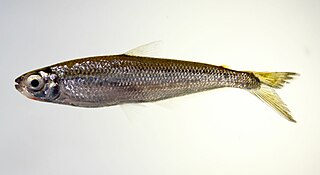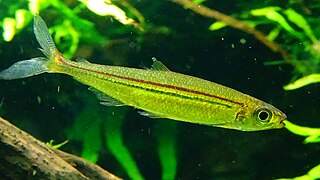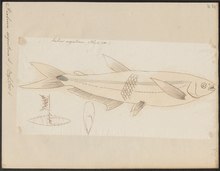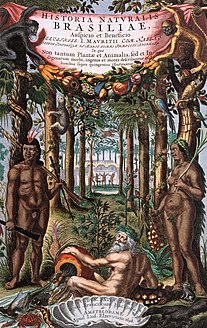
The rummy-nose tetra is a species of tropical freshwater characin fish originating in South America, popular among fishkeepers as a tropical aquarium fish. One of many small tetras belonging to the same genus, it is on average 5 cm (2 in) long when fully grown. The fish is one of several very similar species including Petitella bleheri, and Petitella georgiae, and it is possible that more recently collected specimens available in the aquarium trade are members of one or other of these similar species. The common name applied to most of these fishes is "rummy-nose tetra", though other common names are in circulation.

Bryconops is a genus of freshwater fish in the family Iguanodectidae from South America. It consists of small fish, all under half-a-foot long, with slender bodies and silvery scales, though there is some mild color variation. Several species can be identified by way of a humeral patch, and others have a reddish ocellus, or eyespot, on one or both lobes of the dorsal fin.

Iguanodectes is a genus of freshwater fish found in tropical South America, with eight currently described species. They are all small tetras, none longer than 5 inches, and often have attractive silvery or striped scales, which makes them a target for the ornamental fish industry. Alongside the genus Piabucus, it is in the subfamily Iguanodectinae, which in turn is in the family Iguanodectidae. The genus Bryconops, which is also in Iguanodectidae, makes up a sister clade to Iguanodectinae.

Piabucus is a genus of freshwater tetras in the family Iguanodectidae. All three species are found in South America, largely the Amazon and its major tributaries. None of them are longer than half a foot long, with the largest reaching a maximum size of 12.9 cm (5.1 in), and they are slender, with relatively deep chests and long pectoral fins. Their scales are pale or silvery, with lateral lines that stand out.

Iguanodectidae is a family of freshwater fish in the order Characiformes that lives in South America. It is home to the subfamily Iguanodectinae and the monotypic Bryconops clade. Several species in the family, such as the green line lizard tetra, the tailspot tetra, and the orangefin tetra, are sometimes taken as aquarium fish.

Iguanodectinae is a subfamily of small freshwater fish in the family Iguanodectidae. They are most prominently found in the Amazon river basin and its major tributaries, but they are also known from the Tocantins, Orinoco, and Paraguay rivers. It has two genera, Piabucus and Iguanodectes. Some species in the subfamily are taken from the wild for aquariums, like the red- and green-line lizard tetras. There is minor, but ongoing, debate regarding its taxonomy.

Bryconops alburnoides is a small freshwater fish, approximately 6 inches long at its largest, that lives in the rivers of South America. It has a slender body, with a yellowish dorsal fin and yellow-tinged back scales that fade into silver on its belly. It is largely an insectivore that picks land-dwelling insects from the riverbanks, though it eats much more whenever rain washes prey into the water.

The tailspot tetra is a freshwater fish that lives in the coastal river regions of upper South America. Both its common and scientific names reference the distinct spot of color present on the tail fin, which is one of its defining characteristics. It is a small fish, reaching 4.8 in at its longest. Despite its small size, it is an active swimmer, with a preference for fast-flowing waters.
Bryconops colanegra is a small, slender-bodied species of freshwater fish from South America, about 3.5 in long. It has a black tail fin that bears hints of red, and its scales are dark along the back, transitioning to a silver belly. It is endemic to a single river system in Venezuela, the Rio Caroní.

Bryconops melanurus, sometimes called the tail-light tetra, is a small species of freshwater fish from South America that primarily preys on insects. It lives in small schools and is an active swimmer, which means that it requires open space in its habitat. Nonetheless, it does not demonstrate a strong preference for any one biotope within its native range.
Bryconops allisoni is a species of freshwater fish known from the rivers of Brazil. It is a recent addition to the genus (2019), currently considered a member incertae sedis. Its name honors Antonio Machado-Allison, an ichthyologist responsible for a great deal of work on the genus Bryconops.
Iguanodectes adujai is a species of freshwater fish that inhabits the rivers of South America. It largely prefers slow-moving blackwater habitats, though it has a slender body that suggests a further affinity for flowing water. It has a distinct lateral stripe in two horizontal sections, with bright-red at the top and yellow at the bottom.

Iguanodectes geisleri, the red-line lizard tetra, is a species of freshwater fish from South America. It is a small species, largely herbivorous with some omnivorous traits, that prefers to live in schools and is partial to shallow waters, especially in blackwater habitats. Some aspects of its body plan are unique amongst its genus, including the position and length of the anal fin.
Iguanodectes purusii is a small freshwater fish from the rivers of South America. It is largely herbivorous, and prefers to live in schools. The name "purusii" originates from the species' type locality, the Purus river basin of Brazil, with a range that also extends into Peru. Furthermore, it has been documented from the Amazon, Madeira, Guaporé, and Pastaza rivers, but specific study of its ecology is otherwise lacking.
Iguanodectes spilurus, the green-line lizard tetra, is a small characiform fish from the rivers of South America. It is not a well-studied species, but research is available, including data from hobbyists that keep it as an ornamental fish. It has a distinct lateral stripe of reflective-green scales, and lacks any red markings therein; red is common in congeners' lateral stripes.
Iguanodectes variatus is a small freshwater fish, described from the rivers of South America in 1993. It has a minor presence in the aquarium trade, but lacks the popularity that would make excessive wild capture a legitimate threat. That being said, the threats facing South American aquatic environments are of ongoing concern for the associated biodiversity. Still, I. variatus has been recorded from various rivers and has shown general adaptability to its environment, which speaks to a high survivability.
Piabucus caudomaculatus is a small freshwater fish inhabiting the rivers of South America. It was the first member of the family Iguanodectidae to be reported from Bolivia, and it remains endemic to the region, found solely in the Mamoré river basin. It displays a preference for slow-moving waterways and has a largely insectivorous diet.

Piabucus melanostoma, sometimes called the chin tetra, is a small species of freshwater fish from the rivers of South America. It is the second-largest species of the genus, but still only reaches about 12 cm long. Occasionally found in captivity, it has an appealing iridescent-silver coloration. It is amongst the largest of fish still considered "tetras" in the aquarium hobby.

Astyanax angustifrons, sometimes referred to as the Campeche tetra, is a small freshwater fish from the rivers of Central and South America. It has a healthy distribution across southern Mexico and northern Guatemala, and is relatively common within its native range. Details regarding its diet and behavior are sparse, but it lives in areas with plentiful riparian vegetation, and most other members of the genus are omnivorous. Its habitat includes places affected by pollution and human activity; nonetheless, it is not endangered.
Astyanax bransfordii, sometimes called the longjaw tetra, is a small carnivorous species of fish endemic to a handful of lakes and slow-moving canals in Central America. Its range includes Lake Nicaragua and Lake Managua, which are two of the largest freshwater bodies in Central America; because it occurs only in the relevant areas of Costa Rica and Nicaragua, the area it actually inhabits is somewhat restricted. Its diet largely consists of various invertebrates and smaller fish. This is in contrast to various other species of Astyanax, which are more often omnivorous.










